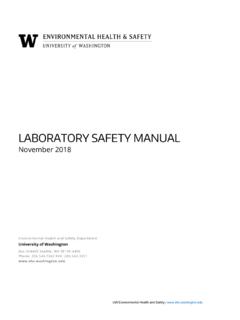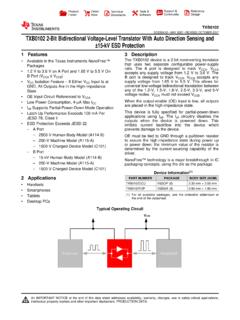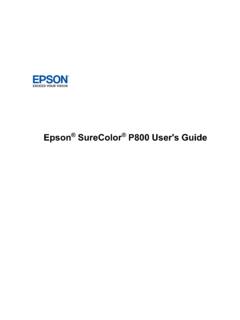Transcription of Chemotherapy and Other Hazardous Drugs Safe Use Guidelines
1 EH&S Research and Occupational safety | 02/2018 Page 1 of 13 Chemotherapy and Other Hazardous Drugs Safe Use Guidelines I. Introduction II. Laboratory Planning and Preparation for Use III. Engineering Controls IV. Personal Protective Equipment (PPE) V. Safe Use Practices VI. Precautions for Agent Administration VII. Agent Spill Cleanup VIII. Acute Exposure IX. Agent Waste Collection and Disposal X. Resources Chemotherapy Glove Permeation Test data Chemotherapy / Hazardous Drug Template SOP EH&S Chemotherapy and Other Hazardous Drugs I. INTRODUCTION The National Institute for Occupational safety and Health (NIOSH) has defined Hazardous Drugs as those that exhibit one or more of the following six characteristics in humans or animals: Carcinogenicity Teratogenicity or Other developmental toxicity Reproductive toxicity Organ toxicity at low doses Genotoxicity Structure and toxicity profiles of new Drugs that mimic existing Drugs determined Hazardous by the above criteria NIOSH recommends that all Hazardous Drugs be handled safely and has published Guidelines in their 2004 NIOSH Alert: Preventing Occupational Exposures to Antineoplastic and Other Hazardous Drugs in Health Care Settings.
2 This applies primarily to workers in health care settings, but also applies to those who work with Hazardous Drugs in research laboratories, which is the focus in this document. Hazardous Drugs include those used for cancer Chemotherapy , antiviral Drugs , hormones, some bioengineered Drugs and Other miscellaneous Drugs . See NIOSH sample listing of major Hazardous Drugs (2014, or most recent edition), the majority of which are Chemotherapy Drugs . Note: The Medical Centers have developed their own Guidelines and procedures for handling Chemotherapy / Hazardous Drugs . The Guidelines in this document focus on use in research settings. EH&S Research and Occupational safety | 02/2018 Page 2 of 13 The nature of Chemotherapy Drugs * (cancer chemotherapeutic Drugs , antineoplastic agents or cytotoxic Drugs ) makes them harmful to healthy cells and tissues as well as cancerous cells.
3 For cancer patients with a life-threatening disease, treatment with these agents can be beneficial. However, for researchers and workers who are exposed to Chemotherapy Drugs as part of their work, precautions must be taken to eliminate or reduce the potential for exposure as much as possible. Chronic effects that have been identified in patients given these Drugs include cancer, infertility, miscarriage, birth defects, damage to the liver and kidney, bone marrow, the lungs and heart, and hearing impairment. Acute effects may include headache, nausea, irritation of eyes, skin and mucous membranes, allergic reactions and skin rash. Employees inadvertently exposed may have similar effects. The risk varies with the specific drug and its concentration and with the frequency and duration of exposure.
4 Other Hazardous Drugs may produce comparable effects. In a research laboratory setting, researchers may be exposed to Chemotherapy or Other Hazardous Drugs by inhalation of agent powder or aerosol produced during preparation, administration or cleanup activities. Skin exposure with agents may occur during preparation or administration of the agent, contact with contaminated work surfaces, clothing and equipment, or by needlestick incidents. Exposure risks can be greatly reduced by (1) making sure that engineering controls such as fume hoods, exhausted biological safety cabinets (BSC) and Other exhausted enclosures are used and (2) using proper procedures and protective equipment for handling Chemotherapy and Other Hazardous Drugs . Principal Investigators (PIs) are required to assess the exposure hazards of their work with Chemotherapy and Other Hazardous Drugs to determine the appropriate precautions and controls to be taken.
5 The assessment includes, at a minimum, the types, forms and volumes of Hazardous Drugs used, the procedures performed, engineering controls, personal protective equipment (PPE), decontamination and cleaning, spill response, waste handling and emergency procedures in case of possible exposure or Other emergency. EH&S will assist PIs as needed in their exposure hazard assessment. PIs must provide personnel laboratory-specific chemical training for the specific agents they are working with. The Hazardous chemical training must include but is not limited to the health and physical hazards of the agents, signs and symptoms associated with exposure, appropriate work practices, PPE, work practices and emergency procedures in case of spill or possible exposure. Review of the safety data sheet /material safety data sheet (SDS/MSDS) is required and practice with less Hazardous materials is recommended prior to work with the agents.
6 Section 7 of the EH&S Laboratory safety Manual has additional information about safety training. * Chemotherapy Drugs are also referred to in this document as antineoplastic agents , chemotherapeutic Drugs , chemo and agents Back to top EH&S Research and Occupational safety | 02/2018 Page 3 of 13 II. LABORATORY PLANNING AND PREPARATION FOR USE 1. Develop a written laboratory-specific SOP specific to the Chemotherapy or Hazardous drug being used. A template SOP is linked to this document to help in preparation of a customized SOP. 2. Provide and document Hazardous chemical training and specific agent SOP training to personnel working with Chemotherapy / Hazardous Drugs and any others authorized or required to be in the laboratory or shared space during work with the agent(s).
7 A sample training documentation form is attached to the template SOP. 3. Ensure the agent SDS/MSDS is available to staff at all times. 4. Enter agent into MyChem inventory, the online UW chemical inventory system. Attach SDS/MSDS in the process 5. Determine any special procedures and precautions needed for the agents used. This may include precautions for work with volatile Chemotherapy Drugs (details given in III. ENGINEERING CONTROLS section). 6. Select appropriate Chemotherapy gloves that will be used with the specific agents. Determine any special procedures and precautions needed if working with agents that may readily permeate Chemotherapy gloves (details given in IV. PERSONAL PROTECTIVE EQUIPMENT section). 7. Designate a laboratory, work space and certified exhausted BSC, fume hood, glove box or Other approved containment for agent work.
8 The laboratory facilities required may vary based on the level of hazard posed by the specific agent and the procedures being performed. 8. Store Chemotherapy and Other Hazardous Drugs in an area labeled chemotherapeutic/ Hazardous Drugs . 9. Post the EH&S Exposure Response Poster in the laboratory. 10. Purchase the smallest amount of agent feasible for work, or purchase the agent in the concentration for use. If possible, do not work with Chemotherapy / Hazardous Drugs in solid or powder form. If it is necessary to purchase it in powder or solid form, purchase pre-diluted or pre-weighed agent in the least quantity needed to perform work. 11. Ensure supplies are available for agent waste handling and disposal, and for routine cleaning of surfaces. 12. Ensure supplies for spill cleanup are appropriate for the specific agent, maintained in a clearly marked spill cleanup kit and readily available in the laboratory.
9 Back to top EH&S Research and Occupational safety | 02/2018 Page 4 of 13 III. ENGINEERING CONTROLS 1. Prepare agents in an exhausted BSC, fume hood, glove box or Other approved containment that does not exhaust into the room. Do not use laminar flow cabinets or hoods for agent work. Consider the properties of the specific agent and procedures when selecting a containment device. Working with intact tablets or capsules is not required to be done in exhausted containment. However, if crushing tablets , perform work in exhausted containment. 2. Do not use a ventilated cabinet that recirculates air inside the cabinet when working with volatile agents. Most agents are not volatile, but some are. The following agents have been reported in publications to be volatile under certain conditions: Carmustine Ifosfamide Cyclophosphamide Mechlorethamine (Mustargen) Doxorubicin ThioTEPA Note: Use special procedures and precautions when working with volatile Chemotherapy Drugs .
10 For more information and guidance, contact an EH&S occupational health and safety specialist at or 206-543-7388, or contact the agent manufacturer. Back to top IV. PERSONAL PROTECTIVE EQUIPMENT (PPE) 1. Wear disposable, powder-free Chemotherapy gloves that are approved by the Food and Drug Administration (FDA) and have been tested for use with Chemotherapy Drugs . These gloves are also recommended for handling Other Hazardous Drugs . Gloves that are labeled as Chemotherapy gloves must be approved by the FDA and be tested by the manufacturer for permeation resistance to specific Chemotherapy Drugs using ASTM standard method D6978-05 Standard Practice for Assessment of Resistance of Medical Gloves to Permeation by Chemotherapy Drugs . The results of permeation testing are available from the glove manufacturer and may be included on the box label and will be reported as breakthrough time , or the time it takes for the chemical to permeate from the outer surface of the glove to the inside surface (tests are conducted for at least 240 min.)




